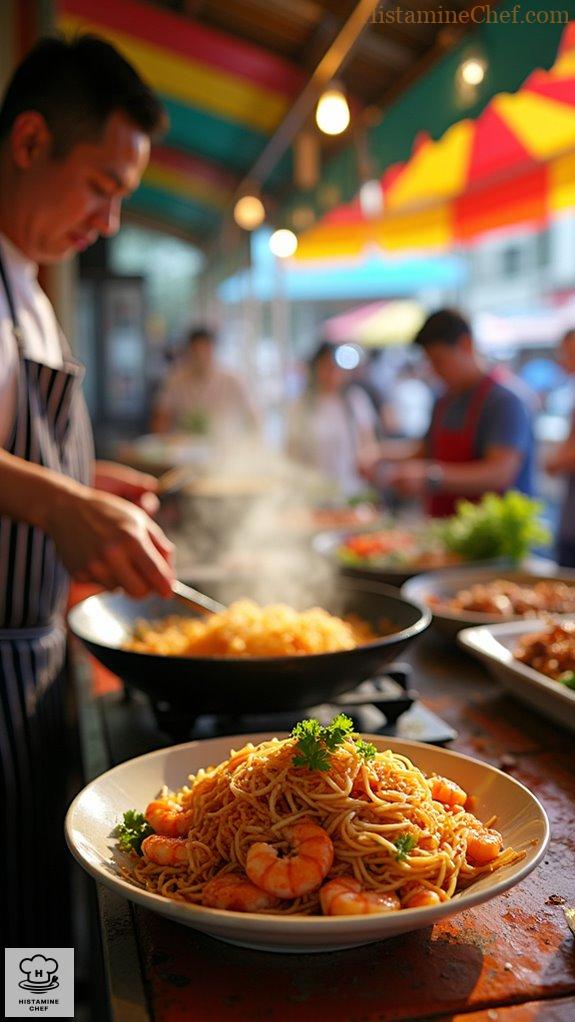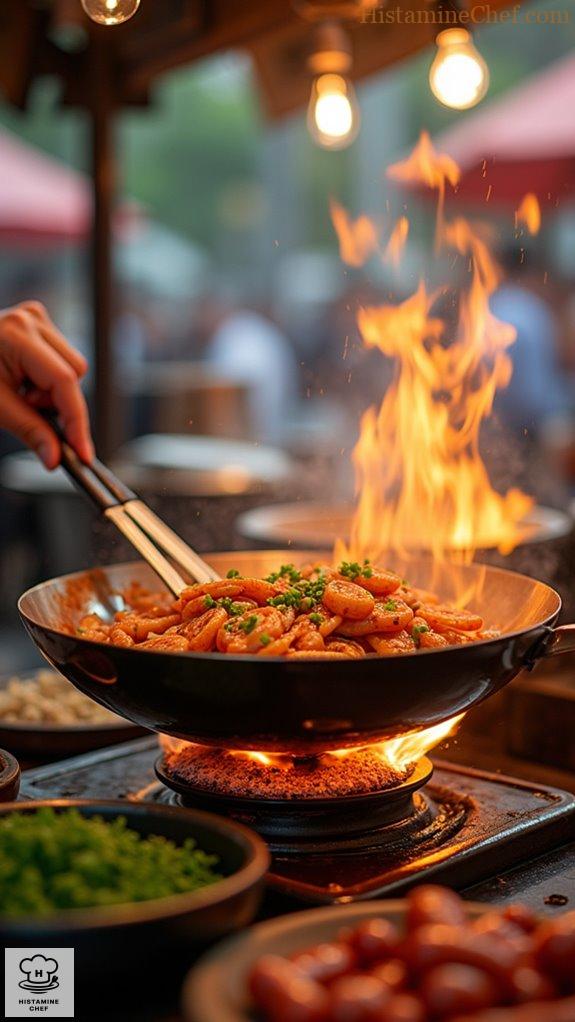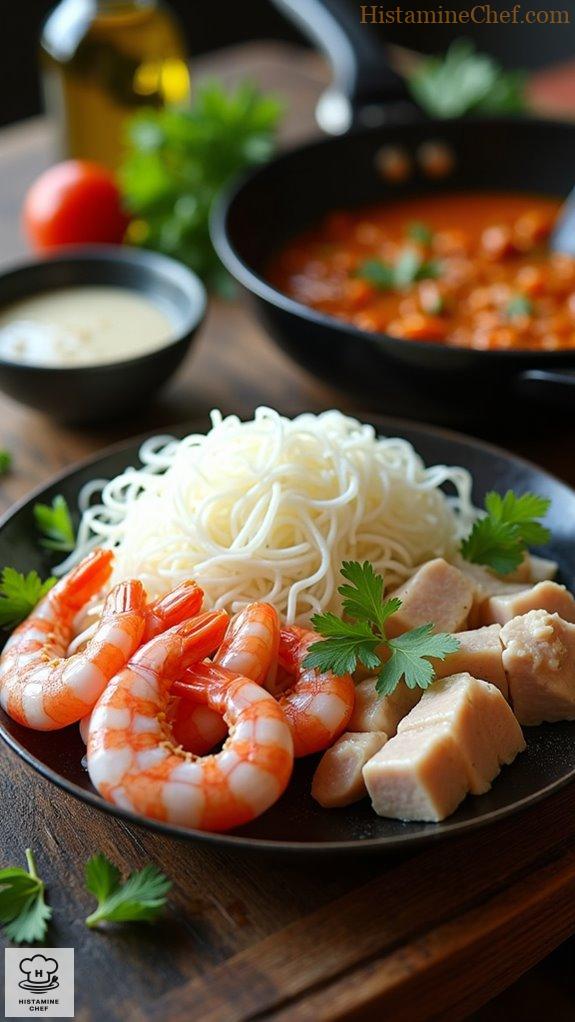Feeling adventurous in the kitchen? Try making a lower histamine char kway teow that bursts with flavor! Picture fresh rice noodles sizzling in a hot wok, paired with juicy shrimp or chicken, and seasoned with low histamine vinegar instead of soy sauce. You’ll want to omit those pesky mushrooms and onions for a safer dish. Trust me, the aromas and textures will make your taste buds dance! Want to impress your guests? I’ve got more tips just ahead!
Cultural Hub of Street Food

Street food culture in Malaysia, particularly in Penang, is a vibrant tapestry of flavors and traditions that reflect the country’s rich multicultural heritage. Known for its bustling hawker centers and food stalls, Penang offers a variety of dishes that showcase the influence of Chinese, Indian, and Malay cuisines.
Char Kway Teow, a beloved Malaysian noodle dish, exemplifies this cultural fusion with its stir-fried rice noodles, prawns, cockles, eggs, and bean sprouts, often cooked over high heat to achieve that signature wok hei aroma.
The history of street food in Malaysia dates back to the early 20th century when migrants brought their cooking traditions to the region, adapting local ingredients and flavors to create unique dishes.
This informal dining experience not only provides affordable meals for locals and tourists alike but also fosters a sense of community as people gather around bustling stalls, sharing food and stories.
Today, street food remains an integral part of Malaysian culture, celebrated for its accessibility, diversity, and ability to connect people through shared culinary experiences.
Wok Hei From High Flames

Street vendors ignite their char kway teow with intense flames, achieving a distinct “wok hei” (breath of the wok) flavor essential to this beloved dish.
They heat large, flat woks over high heat, adding a generous amount of cooking oil to create a sizzling sound upon contact with the hot surface. Fresh rice noodles are quickly tossed into the wok, followed by a precise sequence of ingredients—often accompanied by soy sauce and a dash of seafood for flavor—frying rapidly to maintain the dish’s texture and vibrancy.
Vendors expertly control the flame while continuously stirring for even cooking, allowing the smoky aroma to envelop the street corner, enticing passersby. This fiery method is paramount for achieving that signature charred taste synonymous with authentic char kway teow.
Ingredients:
- 200g fresh rice noodles
- 100g prawns (peeled and deveined)
- 50g Chinese sausage (sliced)
- 2 tablespoons dark soy sauce
- 1 tablespoon light soy sauce
- 2 cloves garlic (minced)
- 1 tablespoon vegetable oil
- Fresh chives (for garnish)
Cooking Steps:
- Heat wok on high flame.
- Add vegetable oil quickly.
- Sauté minced garlic briefly.
- Add prawns and sausage pieces.
- Toss in fresh rice noodles.
- Drizzle dark and light soy sauce.
- Stir-fry rapidly for even cooking.
- Garnish with chives before serving.
Homemade Char Kway Teow Recipe

To make a delicious homemade Char Kway Teow, start by heating a wok over high heat and adding a splash of extra virgin olive oil.
Stir-fry the rice noodles briefly before adding sliced fresh vegetables like bean sprouts and scallions. Incorporate allowed proteins such as chicken or shrimp and keep stirring until fully cooked.
Season with a splash of distilled white vinegar and sweeten with a little sugar, tasting as you go. For a touch of flavor, add fresh garlic or minced herbs, recalling to avoid restricted ingredients like soy sauce or chili peppers.
Serve hot and enjoy your fragrant stir-fried dish!
Changes for Homemade Char Kway Teow:
- Use extra virgin olive oil
- Substitute soy sauce with vinegar
- Add accepted proteins (chicken/shrimp)
- Omit restricted vegetables (like bean sprouts)
- Sweeten with sugar (instead of oyster sauce)
- Use allowed herbs for seasoning
- Guarantee all ingredients are fresh and pure
Low Histamine Variation of Char Kway Teow

Histamine intolerance can complicate one’s relationship with street food, as many popular dishes often contain high-histamine ingredients.
Street food typically features a variety of fermented, processed, or aged components, which can trigger adverse reactions for those sensitive to histamine. Consequently, individuals with histamine intolerance need to be cautious about the foods they consume from street vendors.
Eating street food like Char Kway Teow can be particularly problematic for those with histamine intolerance.
Many of the ingredients typically used, such as soy sauce and certain seafood, are restricted on the SIGHI list due to their high histamine content. In addition, the risk of contamination and cross-contamination in street food preparation can exacerbate intolerances, making it difficult to guarantee a safe meal.
Thus, those impacted by histamine intolerance must consider homemade alternatives to control their dietary intake effectively. Cooking at home allows for greater ingredient control, which is crucial for managing histamine levels.
Low Histamine Variation of Char Kway Teow Instructions:
- Use fresh rice noodles instead of any pre-packaged or aged options.
- Replace soy sauce with a low histamine vinegar like distilled white vinegar.
- Use fresh shrimp or chicken instead; avoid any marinated or processed meats.
- Confirm all vegetables are allowed; avoid mushrooms, onions, and sprouts entirely.
- Use extra virgin olive oil instead of any processed oils or sauces.
- Cook all ingredients freshly; avoid leftovers that may have histamine development.
- Season with fresh herbs instead of restricted spices like chilli or cumin.
- Don’t include any fermented ingredients such as tofu or bean sprouts.
- Limit ingredients to simple, whole foods to minimize histamine risks.
- Serve immediately after cooking to maintain ingredient freshness and safety.
Video Summary
Char Kway Teow is a beloved dish from Southeast Asia, originating in the streets of Penang, Malaysia. In this video, we’ll explore both the authentic street version and a low histamine home adaptation.
Street vendors cook Char Kway Teow with a fiery wok over high heat. They use flat rice noodles, a mix of fresh prawns, and Chinese sausages. Garlic and chives add flavors, while dark soy sauce brings that deep color. Hot oil is essential for that smoky flavor. The key is a quick toss in the blistering heat for perfect texture.
Now, let’s discuss the low histamine version. To start, skip the Chinese sausages and prawns. Instead, use chicken or freshly caught fish for protein. Replace dark soy sauce with a mixture of coconut aminos and a bit of sugar for a sweet-savory touch.
Next, avoid chives and garlic altogether. Opt for fresh basil and green onions instead. Instead of cooking oil, use extra virgin olive oil to keep it low histamine-friendly.
Use a large pan or a wok. Begin by heating the oil over medium heat. Add the chicken or fish if using, and cook until golden. Toss in the flat rice noodles and add the coconut amino mixture. Stir continuously to prevent sticking. Add the fresh basil and green onions last, cooking for just a minute.
The final meal looks vibrant and smells delicious, rich in flavors without histamine spikes. Click the link in the description for the full recipe.


Leave a Reply